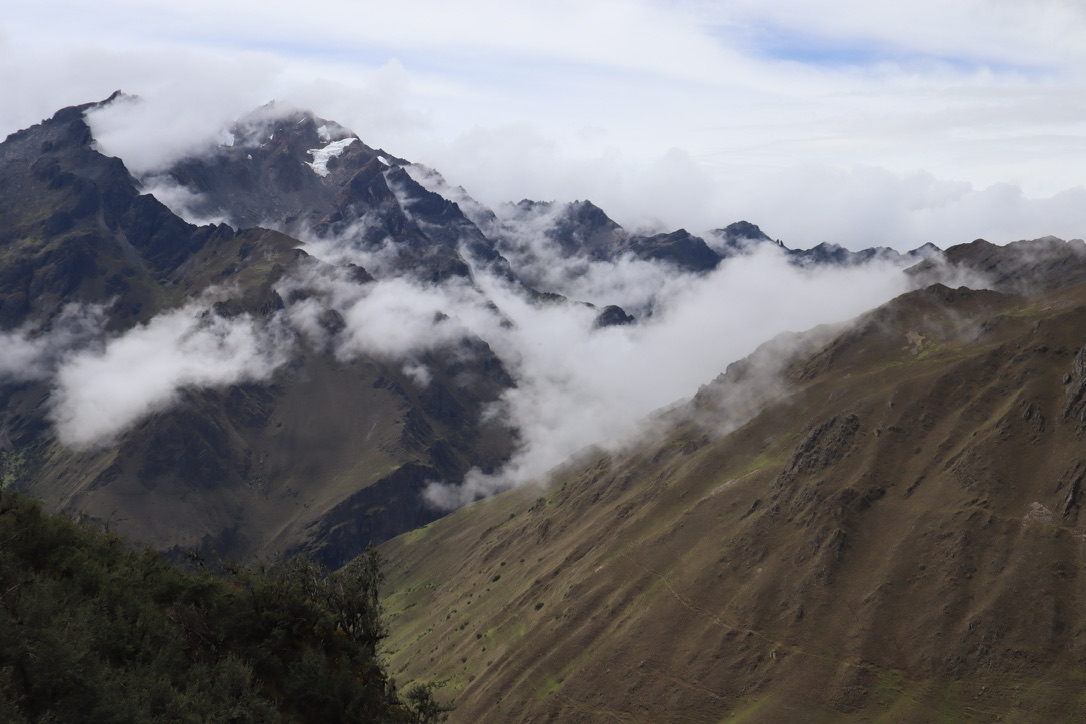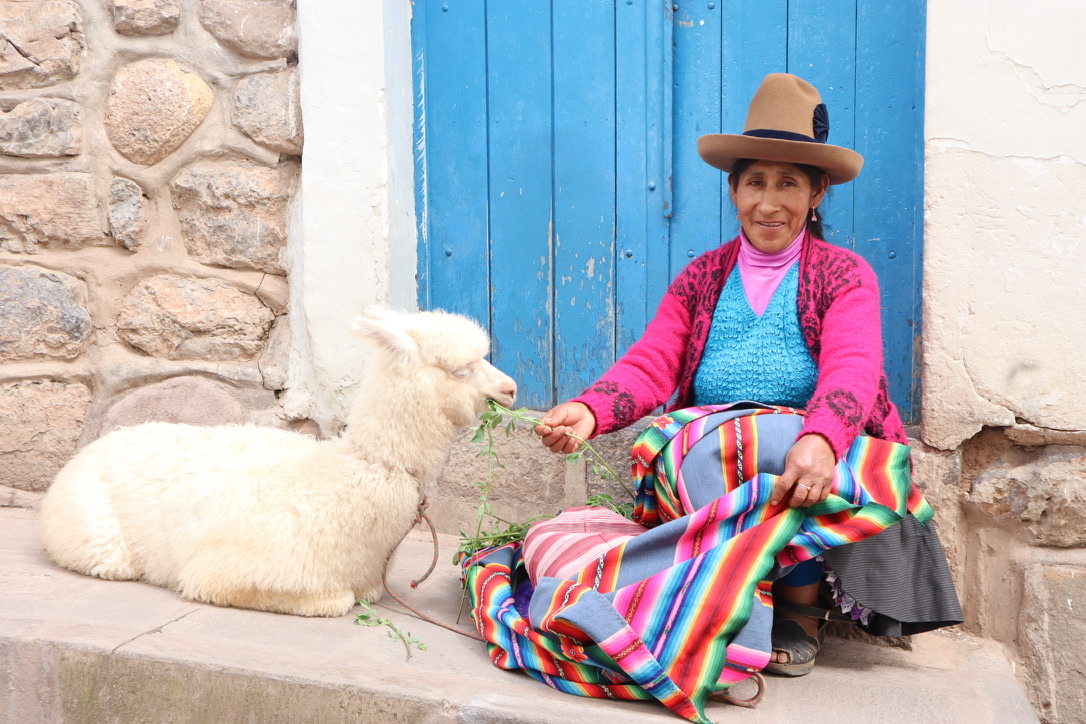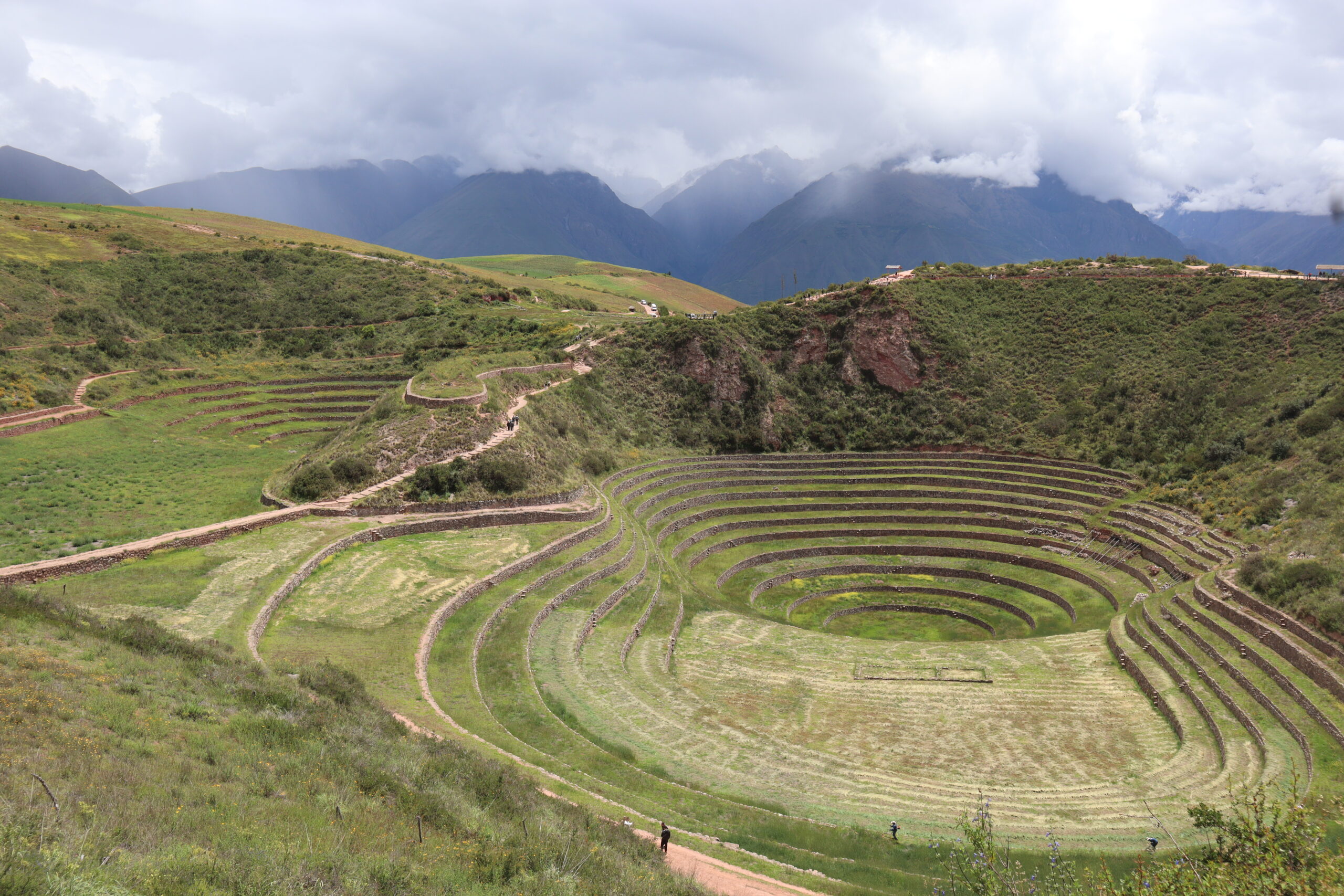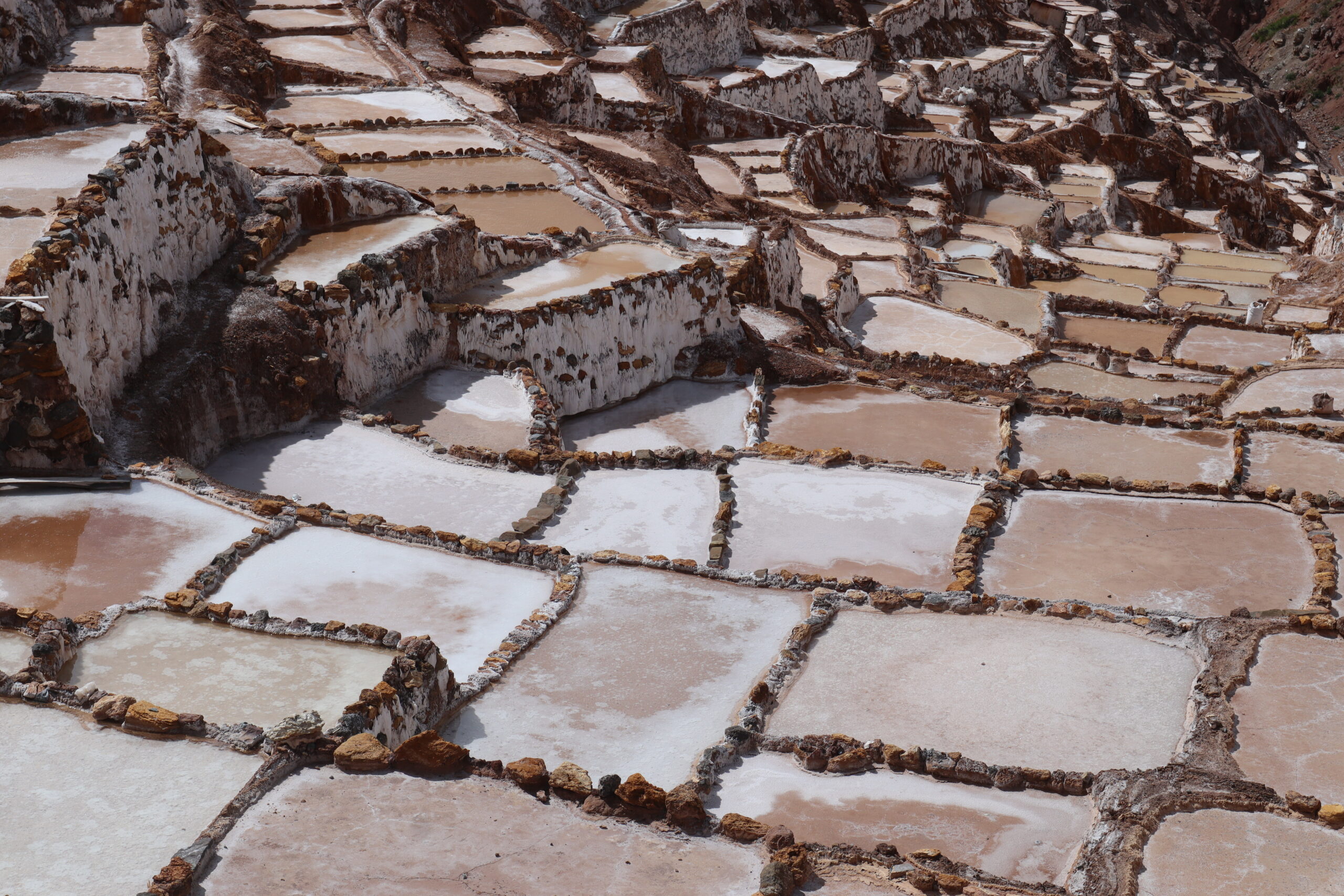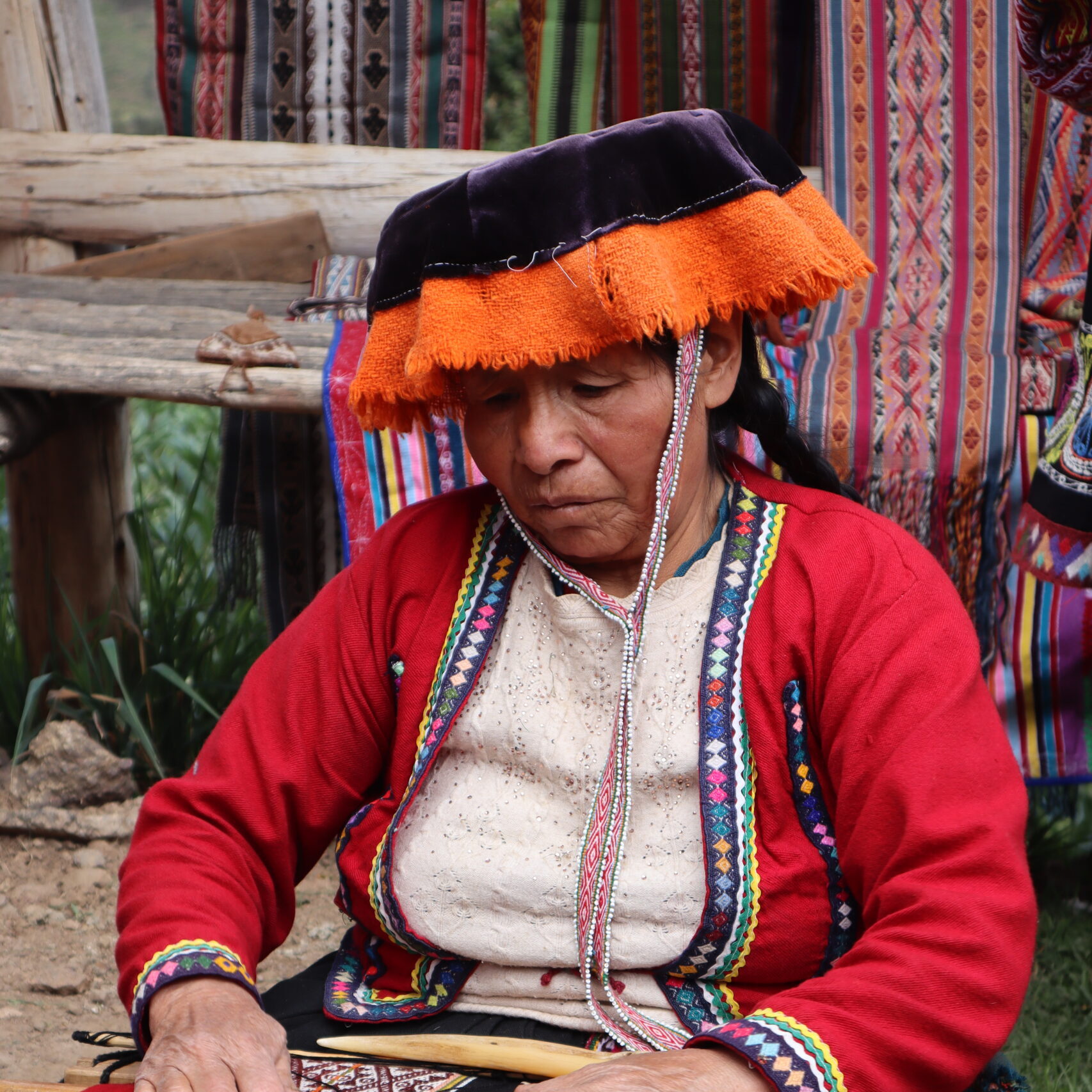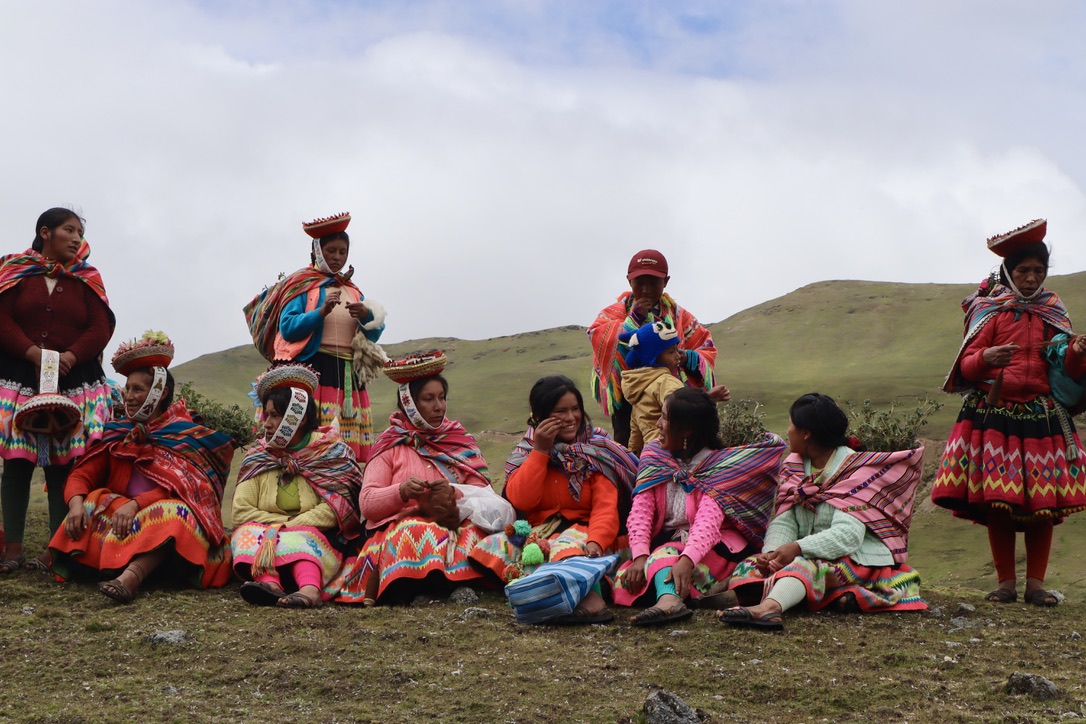I am standing in an old growth polyperis forest, deep in the Andean mountains surrounded by trees over 350 years old, yet no higher than my shoulders. Opposite me is Abra Malaga glacier, teasing us with glimpses of its diminishing magnitude as it peeks out from behind the clouds.
Constantino Aucca and Florent Kaiser, co-founders of Acción Andina (a social movement to help Andean communities restore and protect native forests) have invited Journeys With Purpose to Peru for a community tree planting festival which took place a few days ago. I stand alongside them now, witnessing this deeply moving offering to Pachamama (mother earth) with the laying of coca leaves, chocolate and wine at the base of one of these magnificent life-giving trees. As we pour wine into the earth and blow our wishes on to the wind, the offering draws to a close. Florent turns back towards the valley in time to witness an enormous condor soaring across the sky; his first sighting of this sacred bird in the wild. Perhaps this is a sign Pachamama has heard his prayers?
Sadly, I was too busy taking pictures of the drops of water collecting on the tree branches and the deep orange bark of the native polyperis trees to see the condor myself (to which I continue to berate myself daily). But this was just one of many incredible moments of connection to the earth and to the Peruvian people I experienced during my time as a guest of Acción Andina this March. My first journey to Peru was when I was 18 years old on my first solo expedition through Latin America. I am relieved to say it is still as awe-inspiring, magical and full of surprises to a well travelled 40 year old.In order to acclimatise to the altitudes I was going to experience with Acción Andina I decided to arrive a few days early and really explore the Sacred Valley and all it has to offer! Cusco was my first stop – a city so rich in Incan and colonial history that it deserves at least a few days of exploration! Designed in the shape of a Puma, a symbol of strength of the Inca people, this city has grown exponentially over the 20 years since my first visit but has not lost an iota of charm! Sitting on a bench shadowed by the Cathedral Basilica in the beautiful Plaza de Armas with its colonial arches, street sellers,restaurants and artisanal shops, I nurse a Peruvian coffee and await Nilo, my guide,who will accompany me for the first three days of my trip. I could not have asked for a better person to teach me everything there is to know about ancient Incan practices, engineering, architecture, spirituality and some key Quechuan sayings; my favourite being ‘It’s raining llamas and alpacas’. My first lesson was to always have a big smile and positive attitude and then you don’t get altitude sickness – I liked him already! As a 5ft tall woman with a big smile and a penchant for very colourful clothes I quickly realised that I fit in here!
We wandered along steep cobbled streets through the bohemian San Blas neighbourhood with its white washed walls and colourful blue doors. Andean women were perched on doorsteps spinning colourful yarn whilst simultaneously feeding alpacas – a photo opportunity on every corner! We meandered through the San Pedro market with its hustle and bustle of activity. Vendors were selling everything from barbecued cuy (guinea pig) to alpaca hats and natural remedies for every ailment. One look at the vibrant, colourful market with the magnificent array of produce is enough to understand this is an area with fertile soil and inherent farming prowess. Peru is top of the food chain for producing the World’s best restaurants year-on-year, with Central and Maido frequently topping the charts. If you like your journeys to pack a culinary punch then Peru should be your number one destination!
I spent the next two days in the countryside following the snaking Urubamba River. I visited the awe-inspiring Incan laboratory of Moray with its circular terracing and the breathtakingly huge Maras salt flats, each pond ranging from bright white, through to plaster pink and then deep terracotta. We sat in acid green barley fields with a backdrop of mordor-esque Andean mountains looming over us, whilst enjoying an Andean picnic of ceviche, lightly fried river trout and poached pears drizzled with the sweetest passion fruit (a far cry from my children’s own picnics of ham sandwiches and a packet of hula hoops!).
We trekked from the old defensive Incan fortress of Pumamancha down to the Ollantaytambo, a thriving and slightly touristy town (but no less endearing for it) before popping our heads into Alqa Gallery for a passionate discussion about what defines Andean art. In the owner’s own words, Alqa Gallery acts as a platform for the conservation and dissemination of traditional artistic manifestations. It seeks to generate close alliances with the indigenous communities of the Peruvian Andes and preserve the cultural diversity of these communities currently at risk of extinction. This interaction reiterated the importance of meeting and connecting with knowledgeable and passionate local individuals while travelling to gain a deeper understanding of the cultural heritage of the country you are visiting.
My final day of exploration took me high up into the Andes at over 3500 metres to visit the Amaru community. Here I met a number of families whose expertise lies in weaving and dyeing. Lorenza, our host, gave a thorough demonstration of how natural resources such as flowers, vegetables and even cactus beetles are used to achieve the incredible array of colours used in textile production. 22 shades of red and pink are achieved by using the beetle’s blood and mixing it with sulphur / lime or even a child’s urine (if they do not use urine then you know you are not having an authentic experience, I was told!).
After the demonstration it was all hands on deck for the preparation of the Pachamanca, a Quechuan term translated as ‘earth oven’. It refers to the technique of cooking food underground using hot stones. Three of us were rushing to add a selection of meats, fava beans, pineapple and sweet potatoes into the pit while a dozen others were man-handling hot stones, herbs and a blanket of earth. It was a military operation that had us all collectively laughing uproariously and wiping brows. It turns out you do not need to share a common language in order to get a serious case of the giggles! Lorenza added the final touches of red and yellow flowers to the mound as a thankful offering to mother nature for providing this utterly delicious meal.
On day four, I bid a fond farewell to Nilo who had become like a brother to me and I was ready to start the second phase of my trip. Acción Andina, winner of the 2023 Earthshot Prize and recently recognized as a UN World Restoration Flagship, had brought together a group of likeminded souls from all over the world to witness the Queña Raymi community tree planting festival. Our group consisted of biologists, conservationists, ecologists, non-profit reforestation projects and Earthshot Prize representatives. We all had the shared purpose of learning more from Acción Andina, and by extension Ecoan and Global Forest Generation, and supporting the incredible work they are carrying out in conjunction with the local Andean communities.
Rising at 5.30am on the first morning, the excitement in the group was palpable. This was an event that few people have been lucky enough to witness. We set out on a two hour drive climbing higher and deeper into the Peruvian Andes with Alpacas dotting the landscape and carra carra’s circling the thermals above us. I had to turn my head away from the sheer drop we were careering alongside and steady my nerves by concentrating on the soothing sounds of Andean pan pipes belting out from the van’s stereo!
As the vehicle slowed to a stop I risked opening my eyes again and saw colour everywhere. The Queña Raymi community and three adjoining communities had turned out in their hundreds to all join in this joyful and social event. There was dancing, two young boys blowing conch shells, beckoning those communities from further afield to join the celebration, and a feeling of anticipation in the air. 20,000 polyperis tree saplings lay bunched in a pile ready to be planted. A sparkling lake that provides fish for the community lay just over a hillock with 20,000 holes pre-dug ready for the occasion. The community chose this spot for planting in the hope that the trees and their natural ability to soak up and conserve vast amounts of water will prevent the water level of the lake from futher reducing. The lake is an imperative food source for the community and provides important economic revenue.
Once thanks had been given by Tino, Florent and the Queña Raymi community leader we set off! Plants and young toddlers were hoisted onto the backs of the women and secured with swathes of brightly coloured fabrics. Children and teenagers ran ahead and up the hill, while those less used to the 4500 metre altitude slowly puffed and trudged up behind them, eager to get our hands in the mud and partake in this momentous occasion. Two hours later, 20,000 tree saplings poked out from their new homes in the ground. All those involved formed circles on the hillside and enjoyed a ‘papas’ snack together.I reflected on how honoured I felt to have been involved in this festival and how much I wanted others to experience the thrill of working alongside this remote community in servitude to Pachamama and the generations of Andean communities that will benefit from a steady water source if more funding is given to projects such as Acción Andina.
The following two days were equally as exciting. We visited nurseries run by the local communities where the trees are grown for 8-9 months before planting and saw old growth forests act as sponges, conserving every water droplet that falls on their branches. We witnessed a reforested hillside with trees reaching up to three metres high after only 12 years and exponentially increasing the biodiversity of the area, accentuated by the abundant bird song filling the air. Each evening our group gathered in a circle for a debrief of the day and to share our personal highlights and gratitude. Every day that passed had brought us closer together as a group.
Having these shared experiences reconfirmed for me how wonderful group trips with strangers can be and how you can come away with friends for life, from all walks of life. I returned to the UK after this Peruvian journey determined to continue support for Acción Andina and the communities they serve. In the Quechuan language there is no word for “goodbye”, there is only tupananchiskama which means ‘until life makes us meet again’.
Dig a little deeper
Contribute to Positive Impact on a Hosted Journey.
Connect with Impact Partners around the world during a Private Experience.
